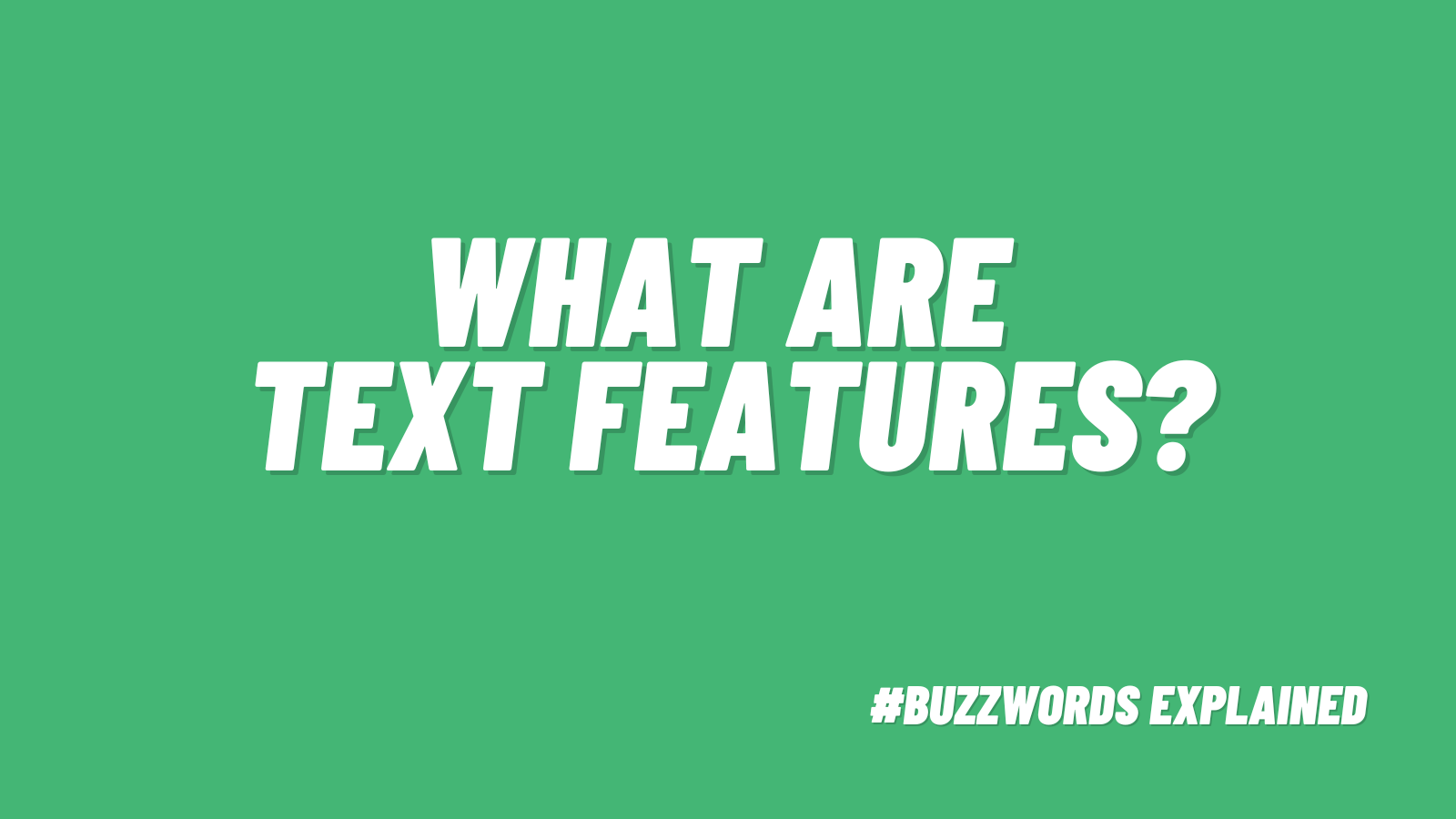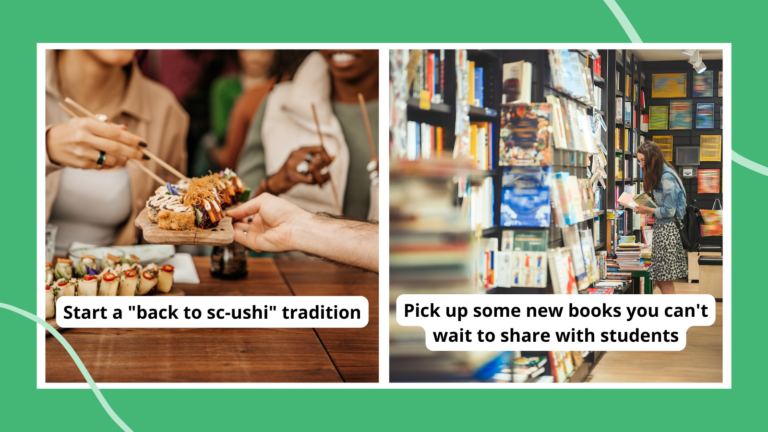As soon as students start reading, they’ll encounter aspects of a text that aren’t, well, text. The table of contents, a photo caption, and a glossary can all be helpful for readers as they make meaning, especially in nonfiction text. Text features should make reading easier, but students do need instruction in how to use text features and practice using them. Here’s our guide to text features, including how to help your students navigate text features like experts.
What are text features?
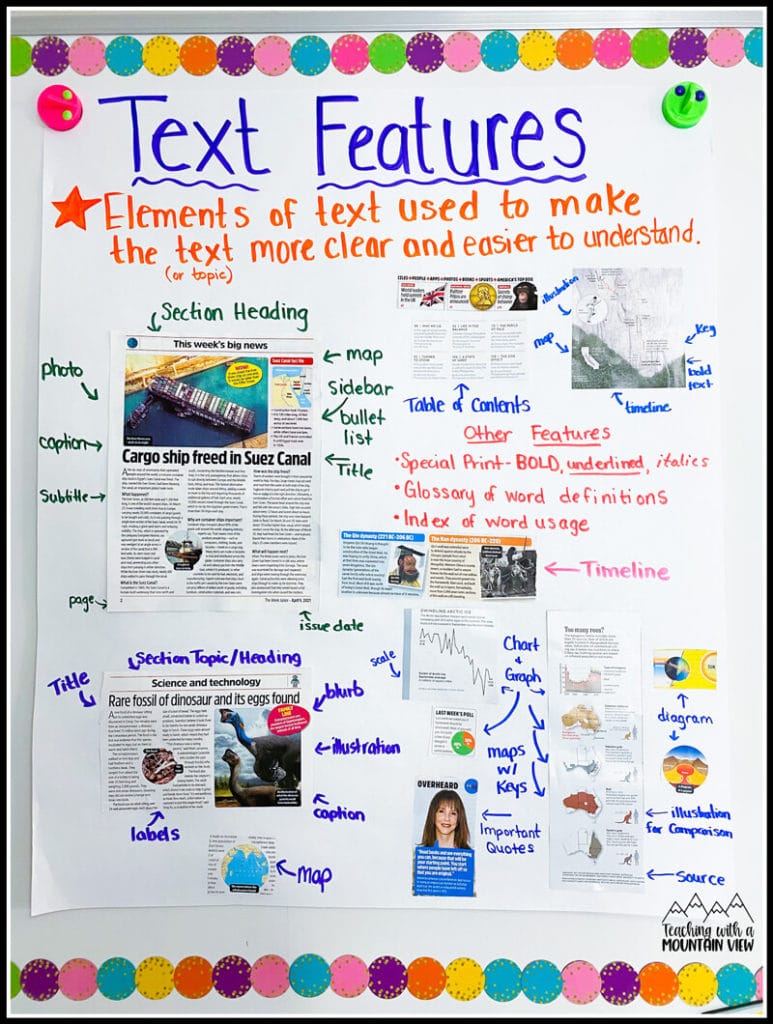
Teaching With a Mountain View/anchor chart via teachingwithamountainview.com
Text features are parts of a text that aren’t in the main story or body of text. They’re most common in nonfiction texts and help readers find information quickly and get more out of the text they’re reading. For example, a photo caption helps students understand more about what’s happening in the picture, so they understand that the photo is not of just some old guy on a boat, but of George Washington crossing the Delaware River. Text features also help students efficiently navigate a text. A table of contents or a glossary allows them to get to the section of text they want without having to skim the entire text.
Here’s a helpful video you can share with students:
Why are text features important?
In short, text features help students get information from a text. When students are able to use text features, they can access the information they need faster and easier. If they have a question about what koalas eat, they can look at the table of contents and don’t have to read the entire book to learn about koala’s diets.
Students will have different levels of proficiency with text features. Stronger readers use text features to their advantage. They’ll take a question or assignment and use text features to improve their reading comprehension. Weaker readers, on the other hand, don’t use text features in the same way and may either read the entire text to find the answer to one question or get bogged down and overwhelmed.
The good news is students can learn to notice and use text features.
Text Feature Examples
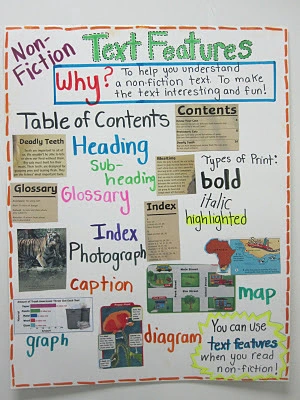
Explorations in Literacy/anchor chart via explorationsinliteracyblog.wordpress.com
Titles and Subtitles
Titles and subtitles (or headings and subheadings) give information about what a section is about. In nonfiction, they may also give important new vocabulary words that help with understanding the meaning of a text. Titles and subtitles also give information about how a text is organized. For example, a text with a chronological structure may have dates in each subtitle to let students know that they are moving through time.
Table of Contents
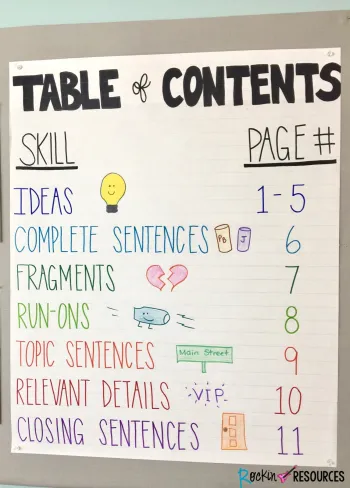
Rockin Resources/table of contents via rockinresources.com
The table of contents is there to help students see how a text is organized so they can go right to the chapter or section they need. It also gives students an idea of what they will learn in each chapter. So, if they’re skimming a table of contents and notice that they’re interested in each of the chapter titles (say: The First Submarines, Today’s Submersibles), then they’ll know that this is a book they want to read, rather than diving into the text and getting bored or frustrated because it’s not something they’re interested in at all.
Glossary
A glossary is at the end of a book and gives information about what’s included in the book through key words or concepts. A student can use a glossary to understand vocabulary, and often where to find more about that vocabulary in a book.
Index
An index is also at the end of a text, but it has a list of topics that are included in the book and where to find each. So, if a student is working on a report about pandas but has a book about Chinese animals, the index is a good place to look for the pages where pandas are discussed.
Sidebar
A sidebar is an informational text box outside of the main text. It includes information that isn’t contained within the general text. Sidebars often include features like graphs, charts, and timelines, which can be helpful for putting information into another form for students to digest.
Pictures and Captions
Pictures show what the text is discussing, and captions help students understand the context for those images. Photos and captions can also give more context about a topic.
Maps
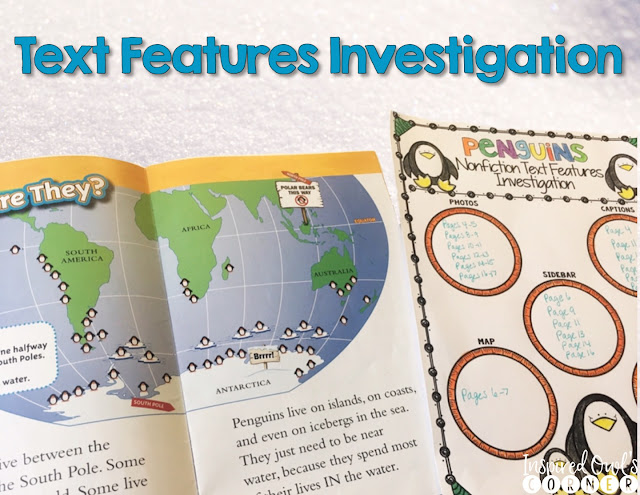
Inspired Owl’s Corner/map example via inspiredowlscorner.com
A map can help readers locate events in a location or period of time. A map of how the troops moved from one country to another during a historical battle would help readers visualize how the war was progressing.
Learn more: Text feature lesson at Inspired Owl’s Corner
Labels and Diagrams
These allow readers to connect vocabulary with images. Labeling the parts of a frog, or a diagram of a frog’s life cycle, puts words to each section or part.
Charts and Graphs
Charts and graphs are a way to show data related to something in the main body of text, and often show additional information depending on the chart.
How To Teach Text Features
Text features, and how to use them, is one of those literacy skills that students can quickly grasp, get good at, and use in any job they do in the future. Students need to notice text features, practice using them with support, and then practice using them on their own.
In this video, Susan Jones Teaching explains ways to introduce text features, like comparing fiction and nonfiction text.
Here are five of our favorite ways to teach text features:
Text Feature Walk
A text feature walk is like a picture walk, but for text features. Text feature walks can be done in any grade, and starting in the elementary grades they help students get used to using text features as a way to preview a nonfiction text. Previewing a text in this way builds background knowledge that students then bring into the text to get more meaning from it when they’re reading.
How to do a text feature walk:
- Choose a text that students have some background knowledge on.
- Give students time to look for and name text features in what they are about to read.
- Have students make predictions, questions, and connections based on the text features they see.
- If there are new words, particularly words that students may not be able to pronounce yet, preview them and have students practice sounding them out before they see them in the text.
- After students have looked at the text features, have them read the text and talk about how the preview impacted their comprehension.
Watch this example:
Read more: Reading Rockets
Text Feature Scavenger Hunt

Classroom Nook/teaching text features via classroomnook.com
The first thing students do when learning text features is notice them. Classroom Nook provides students with a checklist and a nonfiction text. Then, students look through books and check off the text features they find. It’s important, too, that students realize that not all text features will be in every book, and using the checklist with various texts will show them that.
Learn more: Classroom Nook
Sticky Note Text Features
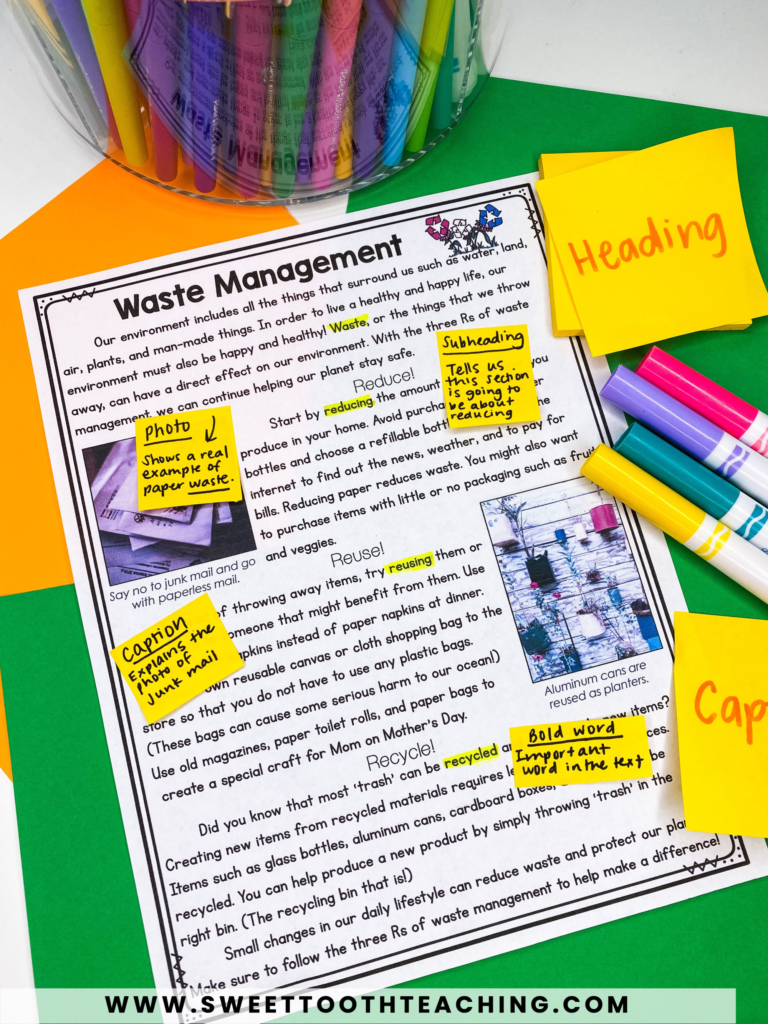
Sweet Tooth Teaching/text feature lesson via sweettoothteaching.com
Give students a text and little sticky notes. Have them label the text features they see. You can do this lesson as a whole group first and then in small groups or individually. You can even use this as a check for understanding to make sure that students are able to name the key features in a text.
Create Living Anchor Charts
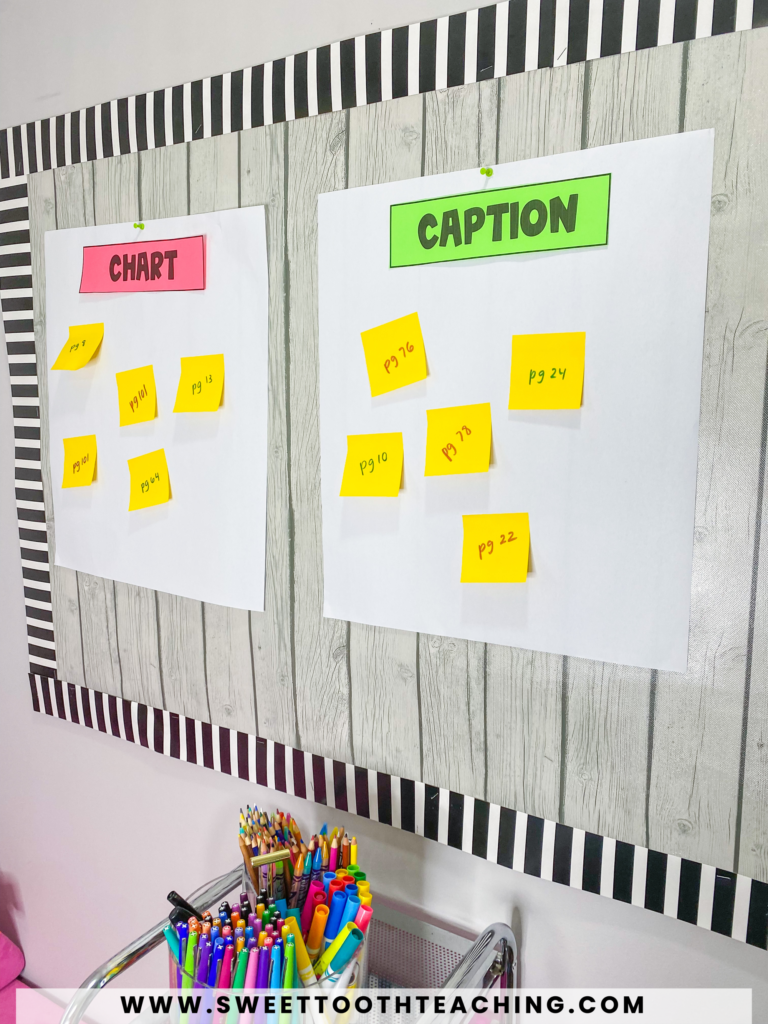
Sweet Tooth Teaching/text feature anchor charts via sweettoothteaching.com
If students are all working with the same text, especially for a longer text, post chart paper with the various text features they will see. Then, have students post a sticky note with the page number and why the author included that text feature for each example they come to.
Learn more: Sweet Tooth Teaching
Teach the Why of Text Features
As you talk about text features in a text, also ask: Why did the author include this text feature? The idea is that each text feature adds something to the reader’s experience (a fun fact in a sidebar that makes readers laugh, a map that shows students the topography of ancient Egypt, for example). This helps students connect text features to the bigger picture: reading comprehension.
What are your favorite ways to teach text features? Join the conversation and exchange recommendations in the WeAreTeachers HELPLINE group on Facebook.
Plus, check out How To Incorporate Literacy Into Your Science Instruction.

We Are Teachers
